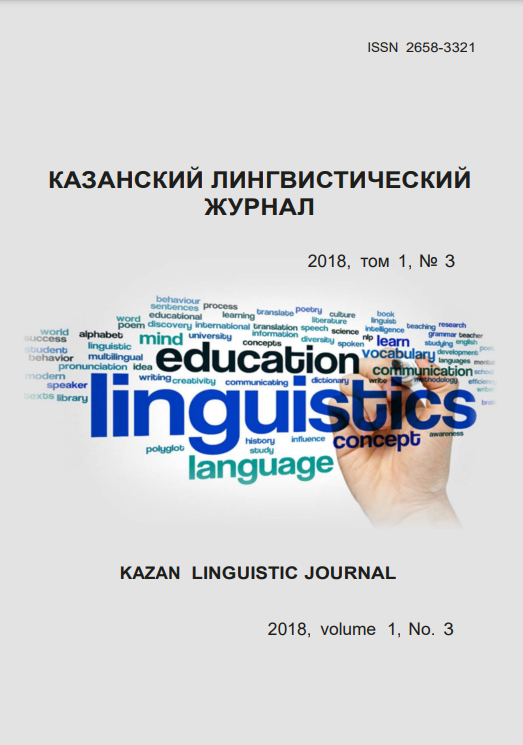Lacunas of tatar culture specific notions in English
Keywords:
equivalent, non-equivalent vocabulary, reality, lacuna, semantic distance coefficientAbstract
Due to the low degree of development of the Tatar reality by the English linguoculture, there is a problem of translating the works of Tatar literature and folklore into English, in order to familiarize the world community with it. One of the translation problems is the problem of translation Tatar cultural concepts into English. To solve this problem, the task to create an English explanatory dictionary of Tatar cultural concepts has been set. The article presents a fragment of the draft of the English explanatory dictionary of the lexical-semantic group “Household Realties” and the calculation of semantic distance coefficient for this group as an indicator of the degree of remoteness of the concept-spheres. During the study, the methods of component and comparative analyses have been used. The semantic distance coefficient for this group made up 8.1, whereas for the ‘Family’ group it made 8.57, for the ‘Food’ group - 9.93, for the ‘Measures and Money’ group 12.7 and for the ‘Religion’ group 12.44. These figures show the degree of remoteness of the concept spheres. The least coincidence of concepts can be observed in the concept sphere “Religion”, which can be explained by different conditions of historical development.
References
Литература
Braçaj, M. (2015). Mediterranean Journal of Social Sciences 6 (1S1), DOI: 10.5901/mjss.2015.v6n1s1 Рp. 476–480.
Longman Dictionary of Contemporary English. Режим доступа: http://www.ldoceonline.com
Said M. (2016) Translating culture-specific concepts (CSCs) from Indonesian into English. Режим доступа: http://www.academia.edu/19975565/translating_culture-specific_concepts_cscs_from_ indonesian_ into_ english.
Верещагин Е.М., Костомаров В.Г. Язык и культура. М., 1990. 246 с.
Налимов В.В. Вероятностная модель языка: о соотношении естественных и искусственных языков. М., 1979. 304 с.
Татарские народные сказки. Книга первая. Татарское книжное издательство. Редакция художественной литературы. Казань, 1958. 359 [на татарском].
Титов В.Т. Общая квантитативная лексикология романских языков. Воронеж: Изд-во Воронеж. гос. ун-та, 2002. 240 с.
Французские и русские реалии в аспекте теории межъязыковой реноминации: монография [и др.] под ред. Н.А. Фененко, А.А. Кретова. Воронеж: изд.-полиграф. центр Воронеж. гос. ун-та, 2013. 220 с.
Электронный словарь ABBYY Lingvo x3 [Электронный ресурс] (СD-ROM).
References
Braaj. M. (2015). Mediterranean Journal of Social Sciences 6(1S1). DOI: 10.5901/mjss.2015.v6n1s1 Рp. 476–480. (In English).
Elektronnyy slovar ABBYY Lingvo x3 [Elektronnyy resurs] (SD-ROM). (In English).
Frantsuzskiye i russkiye realii v aspekte teorii mezhyazykovoy renominatsii: monografiya [i dr.] pod red. N.A. Fenenko. A.A. Kretova. Voronezh: izd.-poligraf. tsentr Voronezh. gos. un-ta. 2013. 220 р. (in Russian).
Longman Dictionary of Contemporary English. Rezhim dostupa: http://www.ldoceonline.com (In English).
Nalimov V.V. Veroyatnostnaya model yazyka: o sootnoshenii estestvennykh i iskusstvennykh yazykov. M. 1979. 304 р. (in Russian).
Said M. (2016) Translating culture-specific concepts (CSCs) from Indonesian into English.
Rezhim dostupa: http://www.academia.edu/19975565/TRANSLATING_CULTURE- SPECIFIC_CONCEPTS_CSCs_FROM_INDONESIAN_INTO_ENGLISH.
Tatarskiye narodnyye skazki. Kniga pervaya. Tatarskoye knizhnoye izdatelstvo. Redaktsiya khudozhestvennoy literatury. Kazan. 1958. 359 р. [in Tatar].
Titov V.T. Obshchaya kvantitativnaya leksikologiya romanskikh yazykov. Voronezh: Izd-vo Voronezh. gos. un-ta. 2002. 240 р.(in Russian).
Vereshchagin E.M., Kostomarov V.G. Yazyk i kultura. M. 1990. 246 р. (in Russian).






